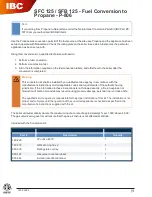
Fulton Boiler FBS Series
FBS 01/05 12
Boil-out of New Unit
The internal surfaces of a newly installed boiler may have oil, grease or other protective coatings
used in manufacturing. Such coatings must be removed because they lower the heat transfer rate
and could cause over-heating of a tube. Before boiling out procedures may begin, the burner should
be ready for firing. The operator must be familiar with the procedure outlined under burner operation.
WARNING
Use of a suitable face mask, goggles, rubber gloves, and protective garments is strongly
recommended when handing or mixing caustic chemicals. Do not permit the dry material or
the concentrated solution to come in contact with skin or clothing. Failure to follow these
instructions could result in serious personal injury or death.
Your local authorized boiler representative will be able to recommend a cleaning or boil-out
procedure. In the event such service is unavailable or is yet unscheduled, the following information
may be of assistance.
There are several chemicals suitable for boil-out. One combination often used is soda ash (sodium
carbonate) and caustic soda (sodium hydroxide) at the rate of 3 to 5 pounds each per 1.000 pounds
of water, along with a small amount of laundry detergent added as a wetting agent.
The suggested general procedure for cleaning a boiler is as follows:
(1) Have sufficient cleaning material on hand to complete the job.
(2) When dissolving chemicals, the following procedure is suggested. Warm water should be put into
a suitable container. Slowly introduce the dry chemical into the water, stirring it at all times until the
chemical is completely dissolved. Add the chemical slowly and in small amounts to prevent excessive
heat and turbulence.
(3) An over-flow pipe should be attached to one of the top boiler openings and routed to a safe point
of discharge. A safety valve tapping is usually used.
(4) Water relief valves and steam safety valves must be removed before adding the boil-out solution
so that neither it nor the grease which it may carry will contaminate the valves. Use care in removing
and reinstalling the valves.
(5) All valves in the piping leading to or from the system must be closed to prevent the cleaning
solution from getting into the system.
(6) Fill the pressure vessel with clean water until the top of the tubes are covered. Add the cleaning
solution and then fill to the top. The temperature of the water used in the initial fill should be at
ambient temperature.
(7) The boiler should then be fired intermittently at a low rate sufficient to hold solution just at the
boiling point. Boil the water for at least five hours. Do not produce steam pressure.
(8) Allow a small amount of fresh water to enter the boiler to create a slight overflow that will carry off
surface impurities.
(9) Continue the boil and overflow process until the water clears. Shut the burner down.
(10) Let the boiler cool to 120
or less.
WARNING
Be sure to drain the hot water to a safe point of discharge to avoid scalding. Failure to follow
these instructions could result in serious personal injury or death.
(11) Remove hand-hole plates and wash the waterside surfaces thoroughly using a high pressure
water stream.
(12) Inspect the surfaces. If they are not clean, repeat the boil out.
(13) After closing the hand-holes and reinstalling the safety or relief valves, fill the boiler and fire it














































